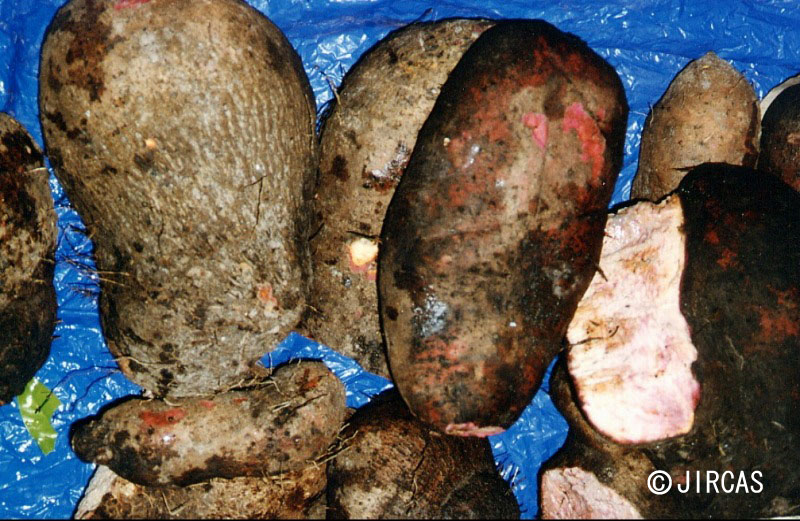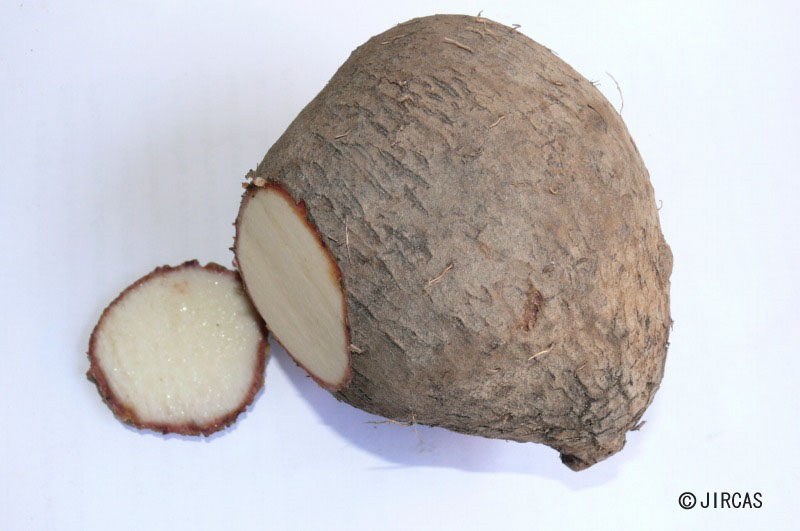Dioscorea alata L. (Dioscoreaceae)
- Scientific name
- Dioscorea alata L.
- Family name
- Dioscoreaceae
- Common name
- Greater yam, purple yam (English); daisho (Japanese)
- Local name
- Man-sao (central), man thu (southern)
Dioecious, annual, glabrous herb, climbing up to 10 m. Stem twining to the right, unarmed, quadrangular and usually conspicuously 4-winged, green to purplish. Axillary bulbils abundant, varying in number among cultivars, tubers usually single, varying in size and shape, globose, short, stout, pyriform, often variously lobed or fingered and fasciculate or curved; brown to black; flesh white, cream, or purplish (superficially or throughout). Leaves simple, alternate towards base, opposite towards apex, subsagittately or subhastately ovate, 10–30 × 5–20 cm, acuminate, 5-veined, bright green, sometimes tinged purplish; petiole length approaching that of blade, sometimes marginally frilled, auriculate at base. Male inflorescence a spike, 1–2 together, aggregated on leafless axillary branches up to 30 cm long, axis sometimes slightly zigzag. Female inflorescence a solitary, axillary spike, up to 60 cm long. Fruit a transversely elliptical, 3-winged capsule, c. 2.5 × 3.5 cm. Seeds orbicular, winged all around.
Common climber in lowland subhumid to humid tropics with annual precipitation of 1,000–1,500 mm. Several local landraces are grown by indigenous peoples in various remote areas of Thailand. Propagated by planting tuber pieces (50–500 g) on mounds, ridges, or flat ground. Tubers and larger bulbils are peeled, boiled, and added to curries, or cooked with coconut milk and sugar as a sweet.
Tubers contain 70 g water, 1.1–2.8 g protein, 0.1–0.3 g fat, 28.5 g carbohydrates (28 g starch, 0.5 g sugar), 0.6–1.4 g fibre, 0.7–2.1 g ash, 0.18 mg vitamin A, 0.09 mg vitamin B1, 0.03 mg vitamin B2, and 5–28 mg vitamin C per 100-g serving.
Tubers contain 70 g water, 1.1–2.8 g protein, 0.1–0.3 g fat, 28.5 g carbohydrates (28 g starch, 0.5 g sugar), 0.6–1.4 g fibre, 0.7–2.1 g ash, 0.18 mg vitamin A, 0.09 mg vitamin B1, 0.03 mg vitamin B2, and 5–28 mg vitamin C per 100-g serving.





